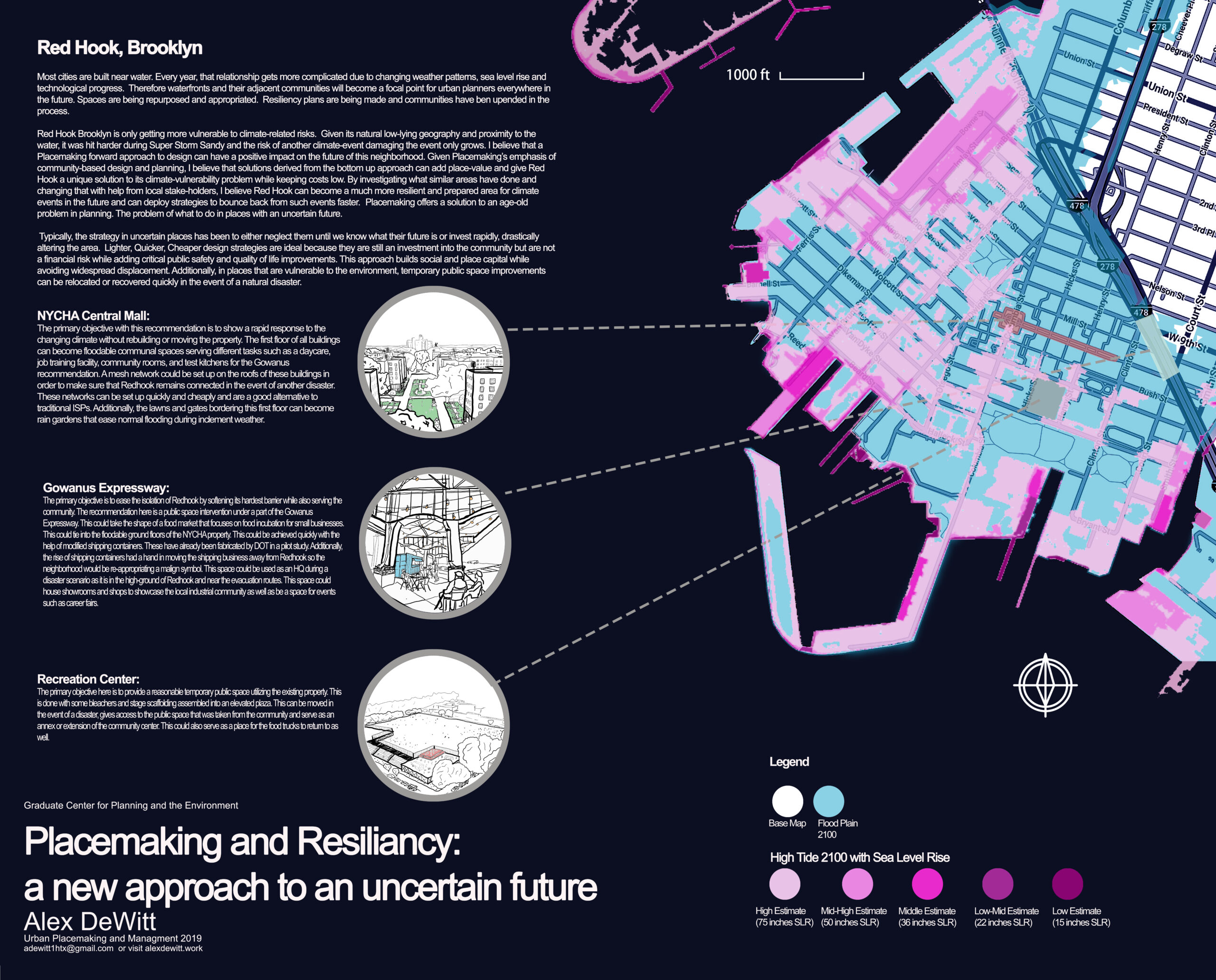Placemaking and Resiliency: a new approach to an uncertain future

Alex DeWitt, MS Urban Placemaking and Management, 2019
Graduate Center for Planning and the Environment
Red Hook, Brookyln
Most cities are built near water. Every year, that relationship gets more complicated due to changing weather patterns, sea level rise and technological progress. Therefore waterfronts and their adjacent communities will become a focal point for urban planners everywhere in the future. Space are being repurposed and appropriated. Resiliency plans are being made and communities have been upended in the process.
Red Hook Brooklyn is only getting more vulnerable to climate-related risks. Given its natural low-lying geography and proximity to the water, it was hit harder during Super Storm Sandy and the risk of another climate-event damaging the event only grows. I believe that a Placemaking forward approach to design can have a positive impact on the future of this neighborhood. Given Placemaking’s emphasis of community-based design and planning, I believe that solutions derived from the bottom up approach can add place-value and give Red Hook a unique solution to its climate-vulnerability problem while keeping costs low. By investigating what similar areas have done and changing that with help from local stake-holders, I believe Red Hook can become a much more resilient and prepared area for climate events in the future and can deploy strategies to bounce back from such events faster. Placemaking offers a solution to an age-old problem in planning. The problem of what to do in places with an uncertain future.
Typically, the strategy in uncertain places has been to either neglect them until we know what their future is or invest rapidly, drastically altering the area. Lighter, Quicker, Cheaper design strategies are ideal because they are still an investment into the community but are not a financial risk while adding critical public safety and quality of life improvements. This approach builds social and place capital while avoiding widespread displacement. Additionally, in places that are vulnerable to the environment, temporary public space improvements can be relocated or recovered quickly in the event of a natural disaster.
NYCHA Central Mall:
The primary objective with this recommendation is to show a rapid response to the changing climate without rebuilding or moving the property. The first floor of all buildings can become floodable communal spaces serving different tasks such as a daycare, job training facility, community rooms, and test kitchens for the Gowanus recommendation. A mesh network could be set up on the roofs of these buildings in order to make sure that Red Hook remains connected in the event of another disaster. These networks can be set up quickly and cheaply and are a good alternative to traditional ISPs. Additionally, the lawns and gates bordering this first floor can become rain gardens that ease normal flooding during inclement weather.
Gowanus Expressway:
The primary objective is to ease the isolation of Red Hook by softening its hardest barrier while also serving the community. The commendation here is a public space intervention under a part of the Gowanus Expressway. This could take the shape of a food market that focuses on food incubation for small businesses. The could tie into the floodable ground floors of the NYCHA property. This could be achieved quickly with the help of modified shipping containers. These have already been fabricated by DOT in a pilot study. Additionally, the rise of shipping containers has a hand in moving the shipping business away from Red Hook so the neighborhood would be re-appropriating a malign symbol. This space could be used as an HR during a disaster scenario as it is the high-ground of Red Hook and near the evacuation routes. This space could house showrooms and shops to showcase the local industrial community as well as be a space for events such as career fairs.
Recreation Center:
The primary objective here is to provide a temporary public space utilizing the existing property. This is done with some bleachers and stage scaffolding assembled into an elevated plaza. This can be moved in the event of a disaster, give access to the public space that was taken from the community and serve as an annex or extension of the community center. This could also serve as a place for the food trucks to return to as well.